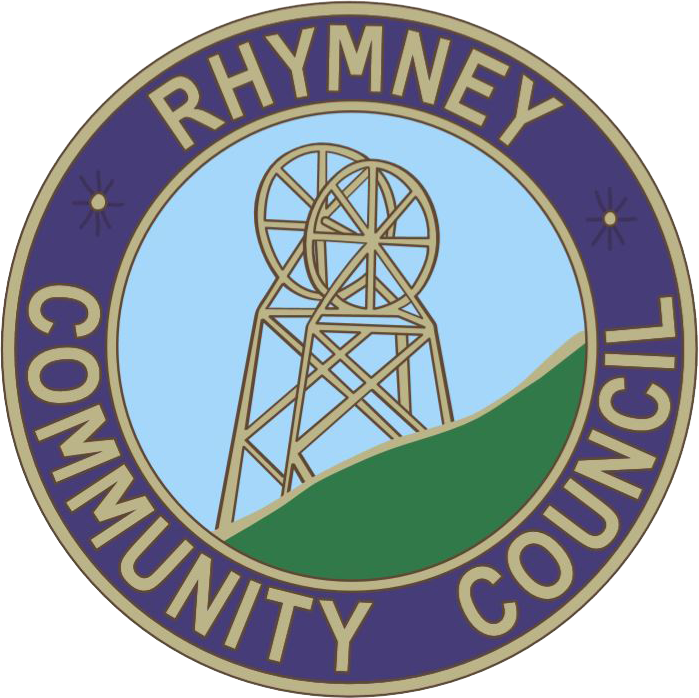About us
The Rhymney Community Council is responsible for the services it provides. It establishes policies for action and decides how money will be raised and spent on behalf of the community. It is responsible for spending public money lawfully and without risk, and for achieving the best value for money.
The ‘Parish’ or ‘Community Council’ originated in the 8th Century and is one of the most ancient types of local government.
The countryside around present day Rhymney would have been very different in the early 17th century. A new parish of Bedwellty had been formed in 1624, covering the lower division of the Wentloog Hundred, in the county of Monmouth, a hilly district between the river Rumney, on the West, and the Sirhowey on the East. The upper Sirhowy Valley at this time would have been a natural well wooded valley, consisting of a few farms and the occasional small iron works where iron ore and coal naturally had occurred together.
Later it would have contained the chapelries of Rhymney and Tredegar, the latter being known as a market town. It wasn’t until the 1750s that industrialisation began with the establishment of the Sirhowy Iron Works. It was from this pastoral pre-industrial period that the Buccaneer Henry Morgan was born around 1635 -the eldest son of Robert Morgan, a farmer living in Llanrhymny,[3] today known as Rhymney three miles from Tredegar. In Welsh the original meaning of Llan is ‘an enclosed piece of land’.
The town was founded with the establishment of the Union ironworks in 1801, with the Rhymney Iron Company later being founded from a merger between the Bute and Union Ironworks in 1837. The ironworks used local coking coal, iron ore and limestone. From the mid-19th century, steam coal pits were sunk to the south of the town. The ironworks closed in 1891 and by the early 20th century the town’s collieries employed nearly the entire local population.
The history of Rhymney is described in Rhymney Memories, a book by Dr Thomas Jones. Jones was born in the town and his daughter, the Labour Party politician Eirene White, was later granted the title Baroness White of Rhymney.
Abertysswg / Abertyswg (aber+tyswg)
This means “mouth of the river Tyswg” – the name of the stream that comes down from the hill above Rhymney Valley and joins the Rhymney River near the village.
Blaencarno (blaen+carn)
A settlement of only a few houses near the village of Rhymney. “Blaen” can mean the headwaters of a river or the head of a valley and this settlement is located near the source of the River Rhymney and the head of the valley that takes its name from it. “Carno” comes from the word “carn” meaning burial mounds as there are many Bronze Age burial mounds in the surrounding area and is also found in the local ward name Twyn Carno.
Bute Town / Y Drenewydd (tre+newydd)
This is an example of the English and Welsh names evolving separately. Now famous for the museum housed in some of the original terraced houses, the English name comes from the Bute Iron Works and the Marquess of Bute, who owned the land in the area. The Welsh name comes from a time when local residents simply referred to it as “the new town” in the area and was described as Newtown in 1875.
Pontlottyn / Pontlotyn (either originally from pont+llydan or possibly pont+y+tlotyn)
Situated near the village of Rhymney, the settlement name was recorded as Pont Lydan in 1754, which means “wide bridge”, the origins of this place name are not clear. The alternative explanation is that it comes from pont-y-tlotyn which means “poor man’s bridge” though there is no definite explanation as to the origin of this name either.
Rhymney / Rhymni (from the word “rhwmp”)
An industrial village that grew up around the Rhymney Ironworks – the Union Ironworks Co. in 1803, with the village and Ironworks taking their name from the river. The name was chosen as the parish name in 1843 and also gave its name to the former district council that served the area from 1974 to 1996. The name of the river appears in 1101 as Remni and goes through a number of changes over the years – Rumeya 1274, Rompney 1314, Rempny 1340. In 1479 the bridge was recorded as pontem Remeebrygge and as Pont Remny / Remney Bridge in 1536-39.
The river rises from a point above a former farm called Blaenrhymni and flows through the valley, leaving Caerphilly county borough after Machen and eventually reaching the sea at Rempney haven or creke as it was shown in 1565, what is today known as Rumney / Tredelerch in Cardiff. Given the many spellings of the name that includes the letter “p”, in all likelyhood the name derives from an old Welsh word “rhwmp” meaning “auger” or “gimlet”, meaning “a river which bores like an auger” to describe how the river has bored or carved its way through the valley.


